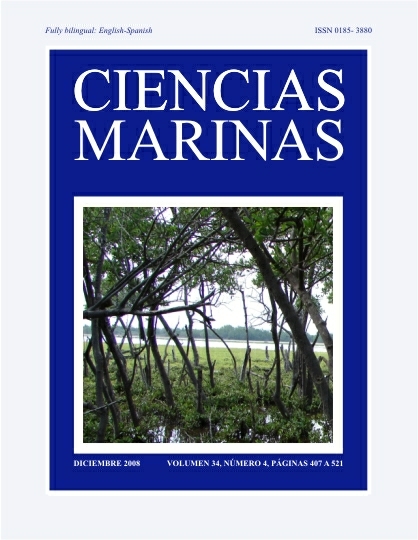Biological and ecological characterization of the catfish Cathorops melanopus off the west coast of Campeche, Mexico
Main Article Content
Abstract
Cathorops melanopus is the most abundant fish on the west coast of Campeche, Mexico. Its distribution is influenced by water temperature, salinity, and transparency, and it is frequently found in river outlets. To analyze the main biological and ecological patterns of this species, from February 2003 to February 2004 a total of 19,048 specimens were collected using a trawl net at 37 sampling stations along the west coast of Campeche. A subsample was formed of 14,446 randomly selected specimens, and each one was measured and weighed (length range = 35–302 mm, mode = 90 mm; weight range = 0.1–224 g, mode = 6 g). The highest mean abundance values were recorded in May (1.24 ind m–2, 15.31 g m–2, and 12.26 g ind–1), and the lowest in April (0.25 ind m–2, 2.5 g m–2, and 9.9 g ind–1). The parameters of the weight/length model were a = 1 × 10–5 and b = 2.96, with a correlation coefficient of 0.95. The relative condition factor showed a major pulse in July (2.1 × 10–5). The female:male ratio was 1:0.69. Of the 159 females collected, 111 had gonads at maturity stages II and III, and only one was in stage IV. The most common food item was unidentified organic matter, which represented 79% of the total stomach content weight and 92.1% of the encountered food types; the second most abundant food item was crustacean remains (4.8% of the total weight and 10% of the encountered contents). Growth parameters were: L∞ = 317.5 mm, K = 0.45, C = 0.7, WP = 0.16, and t0 = 7.5 × 10–12. Total mortality was 1.22, while natural mortality was 0.65. Recruitment patterns showed a significant pulse between July and August, which together contributed 47.65% of the total number of specimens collected.
Downloads
Article Details
This is an open access article distributed under a Creative Commons Attribution 4.0 License, which allows you to share and adapt the work, as long as you give appropriate credit to the original author(s) and the source, provide a link to the Creative Commons license, and indicate if changes were made. Figures, tables and other elements in the article are included in the article’s CC BY 4.0 license, unless otherwise indicated. The journal title is protected by copyrights and not subject to this license. Full license deed can be viewed here.

